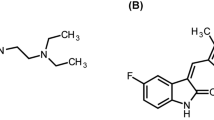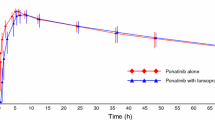Abstract
Objective: To evaluate the effects of multiple doses of omeprazole and of a single dose of an aluminium hydroxide/magnesium hydroxide (Al/Mg) antacid on the single-dose plasma pharmacokinetics of lumiracoxib.
Study Design: Open-label, randomised, three-period, crossover study.
Population Studied: Healthy subjects aged 18–65 years.
Methods: Fourteen subjects who met eligibility criteria were each administered three treatments in random order: (A) lumiracoxib 400mg as a single oral dose; (B) oral omeprazole 20mg once daily for 4 consecutive days, then lumiracoxib 400mg as a single oral dose just prior to oral omeprazole 20mg on day 5; and (C) lumiracoxib 400mg as a single oral dose immediately prior to a 20mL dose of Al/Mg antacid (magnesium hydroxide 800mg and aluminium hydroxide 900mg). The interval between each lumiracoxib dose was 7 days. Analysis of variance was performed to determine whether lumiracoxib alone differed from lumiracoxib plus omeprazole or from lumiracoxib plus Al/Mg antacid for overall exposure (area under the concentration-time curve from zero to infinity [AUC∞]) and peak concentration (Cmax), with treatment sequence, subject, period and treatment as factors. Ratios of geometric means between lumiracoxib plus omeprazole and lumiracoxib plus Al/Mg antacid to lumiracoxib alone (reference) were calculated for AUC∞ and Cmax. If the mean ratios, with 90% CIs, fell within the interval 0.80–1.25, the treatments were considered equivalent.
Results: Arithmetic mean plasma lumiracoxib concentration-time profiles were similar for all treatments, with a rapid rise in concentration after administration, reaching Cmax values (mean ± SD) of 9.24 ± 1.96, 8.81 ± 2.30, and 10.43 ± 3.24 mg/L within 2–3 hours for treatments A, B and C, respectively. AUC∞ was similar for the three treatments (36.75 ± 7.73, 34.88 ± 8.40 and 35.50 ± 5.72 mg • h/L). All ratios of geometric means with 90% CIs fell within the interval used for establishing bioequivalence, except for the Cmax comparison between lumiracoxib plus Al/Mg antacid and lumiracoxib alone, which was 1.11 (0.95, 1.31).
Conclusion: Coadministration of lumiracoxib with omeprazole or with an Al/Mg antacid had no clinically significant effect on lumiracoxib single-dose plasma pharmacokinetics. Lumiracoxib can, therefore, be administered concurrently with either of these agents without need for lumiracoxib dosage alteration.





Similar content being viewed by others
Notes
The use of trade names is for product identification purposes only and does not imply endorsement.
References
Wolfe MM, Lichtenstein DR, Singh G. Gastrointestinal toxicity of nonsteroidal anti-inflammatory drugs. N Engl J Med 1999; 340(24): 1888–900
Guarner F. Prescribing nonsteroidal anti-inflammatory drugs together with antisecretory agents is safe but may be useless. Gastroenterology 1996; 111: 1145–7
AstraZeneca. Prilosec® (omeprazole) [package insert]. Wilmington (DE): AstraZeneca, 2003
Chan FK, Hung LC, Suen BY, et al. Celecoxib versus diclofenac and omeprazole in reducing the risk of recurrent ulcer bleeding in patients with arthritis. N Engl J Med 2002 Dec 26; 347(26): 2104–10
Lanas A, Rodrigo L, Marquez JL, et al. Low frequency of upper gastrointestinal complications in a cohort of high-risk patients taking low-dose aspirin or NSAIDS and omeprazole. Scand J Gastroenterol 2003 Jul; 38(7): 693–700
Maalox® (magnesium hydroxide — aluminum hydroxide antacid) [package insert]. Parsippany (NJ): Novartis Consumer Health, 2003
Andersson T, Bredberg E, Lagerstrom PO, et al. Lack of drug-drug interaction between three different non-steroidal antiinflammatory drugs and omeprazole. Eur J Clin Pharmacol 1998; 54(5): 399–404
Neuvonen PJ. The effect of magnesium hydroxide on the oral absorption of ibuprofen, ketoprofen and diclofenac. Br J Clin Pharmacol 1991; 31(3): 263–6
Warner TD, Giuliano F, Vojnovic I, et al. Nonsteroid drug selectivities for cyclo-oxygenase-1 rather than cyclo-oxygenase-2 are associated with human gastrointestinal toxicity: a full in vitro analysis. Proc Natl Acad Sci USA 1999; 96: 7563–8
Goldstein JL, Agrawal NM, Silverstein F, et al. Celecoxib is associated with a significantly lower incidence of clinically significant upper gastrointestinal events in osteoarthritis and rheumatoid arthritis patients as compared to NSAIDs [abstract]. Gastroenterology 1999; 116(4): G0758
Sigthorsson G, Crane R, Simon T, et al. COX-2 inhibition with rofecoxib does not increase intestinal permeability in healthy subjects: a double blind crossover study comparing rofecoxib with placebo and indomethacin. Gut 2000; 47(4): 527–32
Simon LS, Weaver AL, Graham DY, et al. Anti-inflammatory and upper gastrointestinal effects of celecoxib in rheumatoid arthritis: a randomized controlled trial. JAMA 1999; 282(20): 1921–8
Langman MJ, Jensen DM, Watson DJ, et al. Adverse upper gastrointestinal effects of rofecoxib compared with NSAIDs. JAMA 1999; 282(20): 1929–33
Hawkey C, Laine L, Simon T, et al. Comparison of the effect of rofecoxib (a cyclooxygenase 2 inhibitor), ibuprofen, and placebo on the gastroduodenal mucosa of patients with osteoarthritis: a randomized, double-blind, placebo-controlled trial. The Rofecoxib Osteoarthritis Endoscopy Multinational Study Group. Arthritis Rheum 2000; 43(2): 370–7
Rordorf C, Kellet N, Mair S, et al. Gastroduodenal tolerability of lumiracoxib vs placebo and naproxen: a pilot endoscopic study in healthy male subjects. Aliment Pharmacol Ther 2003; 18: 1–10
Atherton C, Jones J, McKaig B, et al. Pharmacology and gastrointestinal safety of lumiracoxib, a novel COX-2 selective inhibitor: a preliminary integrated study. Clin Gastroenterol Hepatol 2004; 2(2): 113–20
Scott G, Rordorf C, Blood P, et al. Dose escalation study to assess the safety, tolerability, pharmacokinetics and pharmacodynamics of COX189 in healthy subjects [abstract]. Ann Rheum Dis 2002; 61: 242
Mangold JB, Gu H, Rodriguez LC, et al. Pharmacokinetics and metabolism of lumiracoxib in healthy male subjects [abstract]. Drug Metab Rev 2002; 34(1 Suppl.): 141
Data on file, Novartis Pharmaceuticals Corporation, East Hanover, (NJ), USA, 2000.
Marshall PJ, Berry JC, Wasvary J, et al. The in vitro and in vivo selectivity of COX189, a new and highly selective inhibitor of COX-2 [abstract]. Ann Rheum Dis 2002; 61: 259
Scott G, Rordorf C, Milosavljev S, et al. Multiple-dose lumiracoxib shows rapid absorption and COX-2 selectivity without accumulation in patients with rheumatoid arthritis. In: Tulunay FC, Orme M, editors. European collaboration: towards drug development and rational drug therapy [abstract P-197]. Proceedings of the Sixth Congress of the European Association for Clinical Pharmacology and Therapeutics. Berlin: Springer-Verlag, 2003: 124
World Medical Association Declaration of Helsinki. Recommendations guiding physicians in biomedical research involving human subjects. JAMA 1997; 277(11): 925–6
Wilde MI, McTavish D. Omeprazole: an update of its pharmacology and therapeutic use in acid-related disorders. Drugs 1994; 48(1): 91–132
Data on file, Novartis Pharma AG, Basel, Switzerland, 2001.
Center for Drug Evaluation and Research. Bioavailability and bioequivalence studies for orally administered drug products: general considerations [guidance for industry]. Rockville (MD): Food and Drug Administration, Center for Drug Evaluation and Research, 2000
Wilding I, Connor A, Carpenter P, et al. Lumiracoxib shows similar bioavailability at different sites in the gastrointestinal tract. In: Tulunay FC, Orme M, editors. European collaboration: towards drug development and rational drug therapy [abstract P-196]. Proceedings of the Sixth Congress of the European Association for Clinical Pharmacology and Therapeutics. Berlin: Springer-Verlag, 2003: 123
Abelo A, Andersson TB, Antonsson M, et al. Stereoselective metabolism of omeprazole by human cytochrome P450 enzymes. Drug Metab Dispos 2000; 28(8): 966–72
Furuta S, Kamada E, Suzuki T, et al. Inhibition of drug metabolism in human liver microsomes by nizatidine, cimetidine and omeprazole. Xenobiotica 2001; 31(1): 1–10
Neuvonen PJ, Kivisto KT. Effect of magnesium hydroxide on the absorption of tolfenamic and mefenamic acids. Eur J Clin Pharmacol 1988; 35(5): 495–501
Acknowledgements
The authors have provided no information on sources of funding or on conflicts of interest directly relevant to the content of this study.
Author information
Authors and Affiliations
Rights and permissions
About this article
Cite this article
Scott, G., Reynolds, C.V., Milosavljev, S. et al. Lack of Effect of Omeprazole or of an Aluminium Hydroxide/Magnesium Hydroxide Antacid on the Pharmacokinetics of Lumiracoxib. Clin Pharmacokinet 43, 341–348 (2004). https://doi.org/10.2165/00003088-200443050-00006
Published:
Issue Date:
DOI: https://doi.org/10.2165/00003088-200443050-00006




